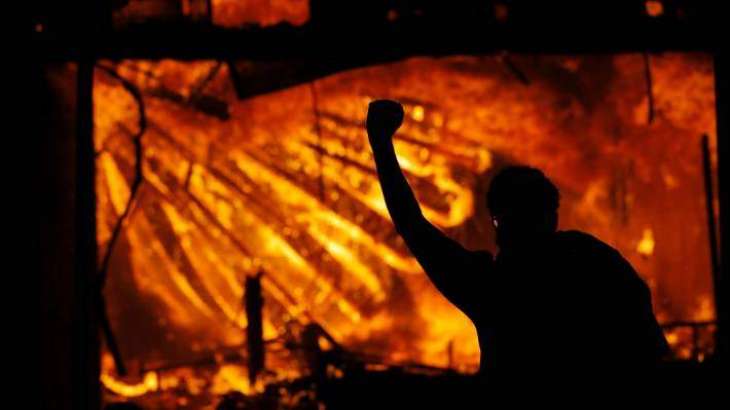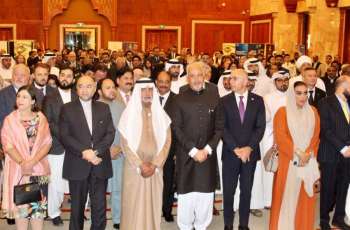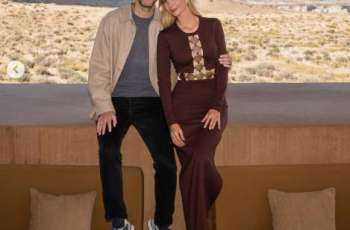The third day of riots in the US city of Minneapolis after an African-American male died in police custody has seen rioters torch a police precinct in the northern city and US President Donald Trump warn that looters will be shot at by troops, as protests sprang up across the country against police brutality
MOSCOW (Pakistan Point News / Sputnik - 29th May, 2020) The third day of riots in the US city of Minneapolis after an African-American male died in police custody has seen rioters torch a police precinct in the northern city and US President Donald Trump warn that looters will be shot at by troops, as protests sprang up across the country against police brutality.
The public unrest follows in the wake of the death of George Floyd, an African-American male, who lost his life this past week after being arrested by law enforcement officers in Minneapolis. On Tuesday, a video spread online showing one of the officers, alleged to be Derek Chauvin, kneeling on Floyd's neck while the latter was handcuffed, lying on his stomach, and pleading for help.
In a press conference on Thursday evening, the FBI special agent in charge Rainer Drolshagen stated that an investigation is ongoing to see if there were any civil rights violations committed during the incident.
Hennepin County Attorney Mike Freeman is leading the investigation into Floyd's death and stated during the press conference that there is other evidence that may not support a criminal charge against Chauvin and the three other officers at the scene of the victim's death.
Freeman added that the four officers are currently not cooperating with investigators.
POLICE PRECINCT TORCHED BY PROTESTERS
Rioters turned their attention to Minneapolis's Third Police Precinct on Thursday evening. According to the Fox news broadcaster, protesters broke into the vacated building at 22:00 local time [03:00 GMT on Friday] and lit a fire.
Law enforcement officers in the building had previously been evacuated by helicopter, the broadcaster said.
On Friday morning, the CNN broadcaster reported that state police dressed in riot gear had assembled near the burning precinct. According to the broadcaster, law enforcement officers sprayed mace at protesters that came near.
In the neighboring city of St. Paul, local police said that over 170 businesses had been damaged during looting on Thursday evening.
"As Thursday turns to Friday, our officers continue to work shoulder-to-shoulder with local, state, Federal, and fire partners to protect St. Paul. More than 170 businesses damaged or looted. Dozens of fires. Thankfully, no reports of serious injuries. Calm on the horizon," the St. Paul Police Force wrote on Twitter.
Earlier in the day, the victim's brother, Philonise Floyd, said that he wanted protesters to act peacefully but understood why people across the United States have turned violent against law enforcement officials.
"I want everybody to be peaceful right now, but people are torn and hurt because they're tired of seeing black men die, constantly, over and over again," Floyd said during an appearance on the CNN broadcaster.
The ongoing violence prompted the mayor of Minneapolis, Jacob Frey, to declare a state of emergency on Thursday, giving the city authorities more flexibility to handle the riots.
"What we have seen over the past several hours and the past couple of nights in terms of looting is unacceptable," Frey said at a press conference on Thursday evening.
One of the measures taken by Frey was to request the assistance of the Minnesota National Guard. During the night, roughly 500 troops arrived in the cities of Minneapolis and St. Paul to provide help to law enforcement officers.
"The in-processing of soldiers and airmen onto State Active Duty continued throughout the night, with nearly 500 soldiers and airmen in position to support rotating missions by morning," the Minnesota National Guard wrote on Twitter.
In a separate Tweet, Maj. Gen. Jon Jensen, Minnesota National Guard adjutant general, said that the deployed troops have been trained to ensure the right of citizens to protest peacefully.
"Our troops are trained to protect life, preserve property and ensure people's right to peacefully demonstrate," Maj. Gen. Jensen said in a statement.
The decision to deploy troops to the region was also backed by Trump, who warned on Twitter that soldiers may open fire if looting continues in Minneapolis and St. Paul.
"Just spoke to Governor Tim Walz and told him that the Military is with him all the way. Any difficulty and we will assume control but, when the looting starts, the shooting starts," Trump wrote in a tweet that was later flagged and hidden by Twitter for breaking the social platform's rules on glorifying violence.
Twitter's decision to censor Trump comes amid a fierce dispute that begun on Tuesday after the social media platform flagged a tweet by the president for containing misleading information.
On Thursday, Trump signed an executive order that could place serious curbs on social media networks' ability to police online content. The president stated that the government will work to enact legislation that will alter or repeal Section 230 of the Communications Decency Act, which provides online platforms protection from civil liabilities for removing harmful or illegal content.
After his tweet about deploying troops to Minneapolis was flagged and hidden, Trump took to Twitter on Friday morning to again call for the repeal of Section 230.
"Twitter is doing nothing about all of the lies & propaganda being put out by China or the Radical Left Democrat Party. They have targeted Republicans, Conservatives & the President of the United States. Section 230 should be revoked by Congress. Until then, it will be regulated!" the president wrote.
VIOLENCE SPREADS ACROSS COUNTRY
Over the preceding two days, violent protests had largely been confined to the cities of Minneapolis and St. Paul. However, this changed on Thursday as public unrest began to spread across the country as part of a general movement against police brutality and the deaths of unarmed African-American individuals at the hands of law enforcement officers
In Louisville, Kentucky, protesters took to the streets to demonstrate against the death of former emergency medical technician Breonna Taylor, who was killed by local police during a raid back in March.
During the protests on Thursday evening, seven people were shot in Louisville, although local police have denied that officers were involved in the shooting. One person remains in critical condition, according to the NBC News broadcaster.
Elsewhere in the United States, more than 72 people were arrested in New York City during protests over Floyd's death, CNN affiliate WPIX 11 reported on Friday morning, citing the chief of the New York Police Department Terence Monahan.
Several law enforcement officers were injured as protests in the borough of Manhattan turned violent and demonstrators began throwing bottles, garbage cans, and other projectiles in the direction of the police.
In the early hours of Friday morning, CNN correspondent Omar Jimenez, a camera crew, and a producer were arrested by law enforcement officers during a live broadcast while reporting on events in Minneapolis.
The incident took place at 05:11 local time [10:11 GMT] as Jimenez was standing in front of rows of law enforcement officers. During the broadcast, the correspondent was heard multiple times stating his affiliation with CNN and asking the officers the reason for him being taken into police custody.
After the arrest, Minnesota Governor Tim Walz spoke with CNN President Jeff Zucker over the phone, the broadcaster stated.
Walz said that he was deeply apologetic for the incident and that he would work to ensure the correspondent's release, the broadcaster reported at the time.
Later on Friday morning, CNN announced that Jimenez and the other members of the team that had been detained by police had been released.
"We're doing OK, now. There were a few uneasy moments there," Jimenez said, as quoted by the broadcaster.
The Minnesota State Patrol clarified the incident and said that the journalists were arrested as officers attempted to clear the streets and restore control.
"In the course of clearing the streets and restoring order at Lake Street and Snelling Avenue, four people were arrested by State Patrol troopers, including three members of a CNN crew. The three were released once they were confirmed to be members of the media," the state patrol said in a post on Twitter.
In the aftermath of the arrest, the Organization for Security and Co-operation in Europe representative on freedom of the media Harlem Desir expressed his concern over Jimenez's arrest and said that journalists must be able to report on events without the fear of being detained.
With charges still yet to be filed over the death of George Floyd, violence is expected to continue throughout Friday and into the evening.
According to the Mapping Police Violence organization, which tracks deaths at the hands of US law enforcement officers, 1,099 people died during arrests or while in police custody in 2019.
The organization says that African-American individuals are three times more likely to be killed by law-enforcement officers than their Caucasian counterparts.




